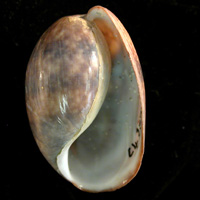|
< Previous family introduction |
|
|||||
 |
Family Bullidae Bubble shells
|
|||||
|
The family Bullidae is a numerically small group of large, rather solid bubble shells that occurs world-wide, mainly in tropical seas but with a few representatives in temperate waters. There are 12 species presently recognised; 2 in the eastern Atlantic, 2 in the western Atlantic, 2 in the eastern Pacific and 6 in the Indo-West Pacific. The definition of the species and their ranges has always been problematic but was clarified somewhat in 2008 when Malaquias and Reid published a study based on anatomy and DNA sequences. In this treatment, there is a divergence from Malaquias & Reid (2008) in recognising Bulla angasi as a valid NSW species rather than treating it as a synonym of Bulla ventricosa. Bulla species occur intertidally and shallowly subtidally, on substrates of sand, mud, and gravel, often among green algae and seagrass. They are nocturnal. During the day they burrow into soft substrates, but can be found exposed in rocky situations. They feed on filamentous green algae, or sometimes on the green alga Ulva. In southern Australia (Vic, Tas, SA and WA) Bulla is represented by only one species, Bulla quoyii. In the 19th century it was known as Bulla australis, but that name had not been properly introduced, and the name was replaced by Bulla botanica, which itself was replaced by Bulla quoyii once it was realised that only one species was involved (Willan 1978). In NSW, as well as Bulla quoyii, Bulla angasi is known from Sydney northwards. Family Reference Malaquias M.A. & Reid D.G. 2008. Systematic revision of the living species of Bullidae (Mollusca: Gastropoda: Cephalaspidea), with a molecular phylogenetic analysis. Zoological Journal of the Linnean Society 153:453-543. Willan, R.C. 1978. The nomenclature of three Pacific Bulla species. Journal of the Malacological Society of Australia 3(1-2): 57-68, 37 figs. Coverage In addition to the 2 species detailed here, Bulla orientalis Habe, 1950, which is a widespread tropical Indo-West Pacific species, has recently been recorded from Hastings Point and the Julian Rocks in far northern NSW. The record of B. ampulla Linnaeus, 1758 from NSW by Nimbs & Smith (2017, p. 53) is an error resulting from the uncritical usage of the name in the Atlas of Living Australia.
|